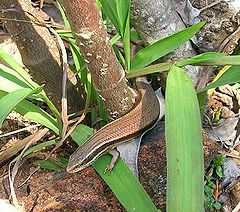Lygosominae
| Lygosominae | |
|---|---|
 | |
| Unidentified Eutropis species from Wayanad (Kerala, India) | |
| Scientific classification | |
| Kingdom: | Animalia |
| Phylum: | Chordata |
| Class: | Reptilia (paraphyletic) |
| Subclass: | Diapsida |
| (unranked): | Sauria |
| Infraclass: | Lepidosauromorpha |
| Order: | Squamata |
| Suborder: | Scleroglossa |
| Infraorder: | Scincomorpha |
| Family: | Scincidae |
| Subfamily: | Lygosominae Mittleman, 1952 |
| Genera | |
|
Numerous, see text | |
Lygosominae is the largest subfamily of skinks in the family Scincidae. The subfamily can be divided into a number of genus-groups. If the rarely used taxonomic rank of infrafamily is employed, the genus-groups would be designated as such, but such a move would require a formal description according to the ICZN standards.[1]
Also, several Lygosominae genera were notorious "wastebin taxa" in the past, with scientists assigning more or less closely related species to them in a haphazard fashion and without verifying that the new species were close relatives of the genera's type species. What was once placed in Lygosoma for example is nowadays divided among some 15 genera. Similarly, Mabuya and Sphenomorphus are having species moved elsewhere even today.[2] Obsolete genera include Euprepis.
Egernia group
- Corucia – Solomon Islands Skink
- Cyclodomorphus
- Egernia – (paraphyletic: including Bellatorias, Liopholis and Lissolepis which are better regarded as distinct)
- Tiliqua – blue-tongued skinks
Eugongylus group
- Bassiana (= Acritoscincus) – "cool-skins"
- Carlia – four-fingered skinks
- Cryptoblepharus – snake-eyed skinks, shining-skinks
- Emoia – emoias
- Eugongylus – mastiff skinks, short-legged giant skinks
- Lampropholis – Indo-Australian ground skinks
- Leiolopisma
- Niveoscincus – snow skinks, "cool-skins"
- Oligosoma
Mabuya group
- Mabuya – American mabuyas

Sphenomorphus group
- Anomalopus – worm-skinks
- Ctenotus – comb-eared skinks
- Eulamprus – water skinks
- Gnypetoscincus – Prickly Skink
- Lipinia – lipinias
- Sphenomorphus – common skinks (paraphyletic)
Undetermined
- Apterygodon (disputed)
- Chioninia – Cape Verde mabuyas
- Eremiascincus
- Eutropis – Asian mabuyas (formerly in Mabuya; Mabuya group?)
- Glaphyromorphus
- Hemisphaeriodon – pink-tongued skinks
- Lamprolepis – tree skinks
- Lerista
- Lobulia
- Lygosoma – writhing skinks
- Saproscincus – shade skinks
- Scincella – ground skinks
- Trachylepis – Afro-Malagasy mabuyas (formerly in Mabuya; Mabuya group?)
- Tribolonotus – crocodile skinks (Egernia group?)
"Hinulia" elegans, described by Grey in 1838, is unidentified, but may be Eulamprus tenuis.[2]
Footnotes
References
| Wikimedia Commons has media related to Lygosominae. |
- Austin, J.J. & Arnold, E.N. (2006): Using ancient and recent DNA to explore relationships of extinct and endangered Leiolopisma skinks (Reptilia: Scincidae) in the Mascarene islands. Mol. Phylogenet. Evol. 39(2): 503–511. doi:10.1016/j.ympev.2005.12.011 (HTML abstract)
- Shea, G.M. & Michels, J.P. (2008): A replacement name for Sphenomorphus keiensis (Kopstein, 1926) from the southeastern Moluccas, Indonesia (Reptilia: Squamata: Scincidae) with a redescription of the species. Zoologische Mededelingen Leiden 82(52): 737-747. PDF fulltext